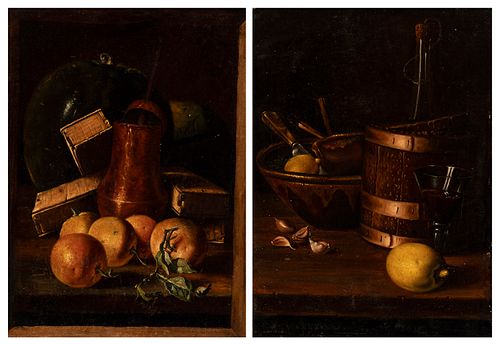Spanish school, following models of LUIS EGIDIO MELÉNDEZ (Naples, 1716 - Madrid, 1780); circa 1800. "Couple of still lifes". Oil on canvas.
Lot 55
About Seller
Setdart Auction House
Carrer Aragó 346
Barcelona
Spain
Setdart Subastas was born in 2004 and is currently the first online art auction in Spain with solidity, prestige and reliability guaranteed by our more than 60,000 users. Setdart has a young, dynamic and enterprising team ready to successfully manage the purchase and sale of art works through custom...Read more
Estimate:
EUR€3,000 - EUR€4,000
$3,125 - $4,166.67
Absentee vs Live bid
Two ways to bid:
- Leave a max absentee bid and the platform will bid on your behalf up to your maximum bid during the live auction.
- Bid live during the auction and your bids will be submitted real-time to the auctioneer.
Bid Increments
| Price | Bid Increment |
|---|---|
| EUR€0 | EUR€10 |
| EUR€200 | EUR€25 |
| EUR€500 | EUR€50 |
| EUR€1,000 | EUR€100 |
| EUR€3,000 | EUR€200 |
| EUR€5,000 | EUR€500 |
| EUR€10,000 | EUR€1,000 |
| EUR€20,000 | EUR€2,000 |
| EUR€50,000 | EUR€5,000 |
About Auction
By Setdart Auction House
Nov 10, 2021
Set Reminder
2021-11-10 08:00:00
2021-11-10 08:00:00
America/New_York
Bidsquare
Bidsquare : 19th & 20th Century paintings and Decorative Arts
https://www.bidsquare.com/auctions/setdart-auction-house/19th-20th-century-paintings-and-decorative-arts-7800
Setdart Auction House sofia@setdart.com
Setdart Auction House sofia@setdart.com
- Lot Description
Spanish school, following models of LUIS EGIDIO MELÉNDEZ (Naples, 1716 - Madrid, 1780); circa 1800. "Couple of still lifes". Oil on canvas. Measurements: 51 x 37 cm (x2); 60 x 46 cm (frames, x2). Both still lifes, which differ slightly from each other, present an identical pictorial conception. The author has aesthetically departed from the baroque tradition, arranging the elements on a flat surface, using a frontal perspective and playing with the different levels or heights of the composition. The illumination also has certain reminiscences and tenebrist, since in both canvases the author presents us with dark compositions with very defined light focuses. For all these characteristics we can relate this still life to the production of Luis Egidio Meléndez, a continuator of the brilliant Hispanic execution of the 17th century and author of magnificent still lifes, a genre that was his specialty, although he also worked on figure themes. A Spanish painter born in Italy, he was the son of Francisco Antonio, the miniaturist, and nephew of Miguel Jacinto, the portraitist. He began his education in Madrid with his father, and later followed the classes of the Preparatory Board of the Academy of San Fernando, being a student of Louis-Michel van Loo. The expulsion of his father from the board determined his dismissal from academic studies, so the young Meléndez made a trip to Italy to continue his education. Upon his return to Spain he initially worked as a miniaturist, but his preponderant role was developed in still life, becoming one of the most outstanding still life painters in the history of the genre, and undoubtedly the most brilliant of the Spanish eighteenth century. In fact, he is represented in the most prominent art galleries around the world, including the Prado and Louvre museums. Meléndez is an expert in the treatment of surfaces, showing an extraordinary ability to give an idea of the qualities of things: fruits, dead animals, ceramics, glass, cork, textiles, metals or stone. Although in some canvases he introduces the landscape background that brings them closer to the Neapolitan still life, most of his works are similar in form and concept to the one we present here, with several elements arranged in a clear structure on the surface of a table placed parallel to the lower edge of the painting, highlighted on a dark background that links directly with the Spanish masters of the XVII century. A master of expressive force and almost a magician of technique, Meléndez reflects, in his desire for accuracy, the principles of the illustrated world in his application to describe the elements in a way that can be understood as didactic. We can find similar characteristics to those of this still life in works by Meléndez such as "Still Life with Cucumbers, Tomatoes and Containers", "Still Life with Two Partridges, Onions, Garlic and Vessels" or "Still Life with Salmon" (Prado), among others.
- Shipping Info
-
In-house shipping available. Please inquire at admin@setdart.com.
-
- Buyer's Premium



 EUR
EUR CAD
CAD AUD
AUD GBP
GBP MXN
MXN HKD
HKD CNY
CNY MYR
MYR SEK
SEK SGD
SGD CHF
CHF THB
THB

















